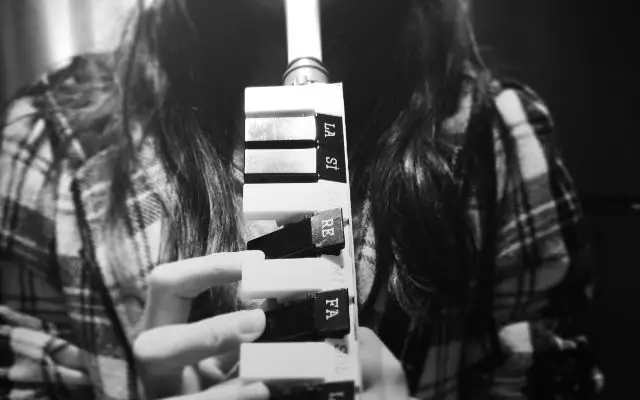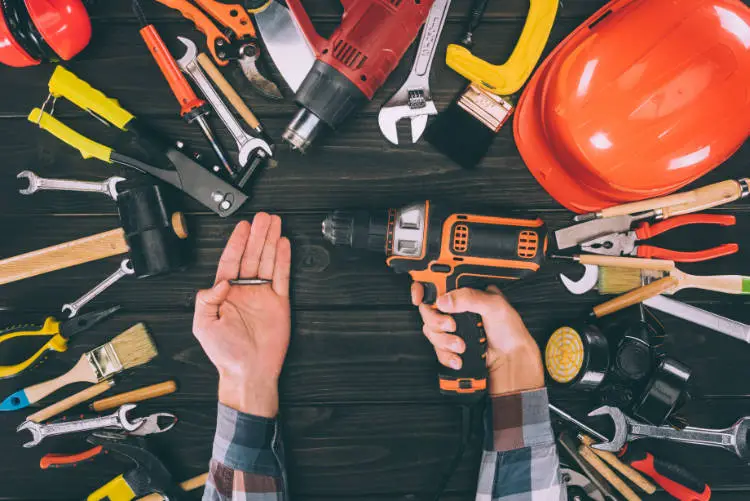If you’re new to the world of melodicas you might be wondering how the instrument is actually played. If you’re here, chances are good that you’ve seen others playing a melodica. You’ve probably wondered what they’re doing to get all those cool sounds. Just like any other instrument, learning to play the melodica takes practice and patience.
How to hold a melodica
The melodica actually gives you quite a bit of freedom when it comes to holding and playing the instrument. It’s most commonly held like a trumpet with the left hand while the keys are played with the right. However, this isn’t the only way to play a melodica. You should play the melodica in the way that best fits your skill level and your setting.
Playing the melodica on a table or your lap
One of the great things about melodica is that you can play it flat on a table or on your lap, like a very small piano or keyboard. If you’re learning piano with your melodica, taking lessons, or just teaching yourself online, the melodica gives you a fantastic way to practice almost anywhere. When you play the melodica flat like a piano, you’ll attach a longer flexible tube that will allow you to sit up straight and blow without holding the melodica up to your mouth. On a larger melodica, this position even allows you to play with both hands.
Some of the articles on our site contain affiliate links. We're careful about what we review and recommend. As an Amazon Associate, we may earn something small from qualifying purchases. Thanks for the support!
If you haven’t picked up a melodica yet, think carefully about the size that’s right for you. Will you be using mostly in one place, flat like a piano? Are you planning on taking it to the beach or the park often? If you need some info and guidance on the decision, check out our writeup on 32 vs 37 key melodicas to start.
Remember that when you’re playing a larger melodica, and when you’re pressing down more keys at once, you’ll need to use more breath to get good volume. Also, higher quality melodicas require less breath overall because they tend to be sealed better, keeping the air inside and moving it over the reeds.
Playing flat like this also opens up a lot more different kinds of music to play. For instance, you’re able to play any piano piece that fits within the range of your melodica.
Holding the melodica up to your mouth
More commonly, you’ll see musicians playing the melodica while they’re holding it up to their mouth like a trumpet. It was made to be very portable and easy to handle, even for kids. So, it’s not a surprise that it’s caught on with musicians who like to move around the stage and play as if they were holding a saxophone or some other woodwind.
When you’re playing this way, you’ll primarily use a short mouthpiece that’s only a couple of inches long. Some people do still use the longer flexible tube when they’re on stage or walking around, but it’s a lot less common. The size of your melodica does make a bit of difference here too. If you have a small soprano melodica, holding it up to your mouth for long periods of time isn’t a problem. However, if you’re playing a large, professional-level melodica that weighs significantly more, you might want to try the flexible tube as well.
Are melodicas for right-handed people only?
It’s true that the configuration of the melodica kind of forces you into playing the keys with your right hand. I say “kind of” because people are creative. I’ve seen people use a flexible tube and basically play backwards using their left hand on the keys. While it’s not common and may not be “correct,” this is music, and you should do whatever works for you.
Also, if you are going to learn piano or keyboards, you will most definitely need to use your right hand to play. So, this isn’t all that limiting if you think of it that way. It’s actually great practice either way. I suggest trying to play the keys with your right hand first. If, after some practice, it still feels too awkward, then try other options.
The basic technique
If you’re using an alto or tenor melodica, you’ll want to hold it with your left hand, as mentioned, and play the keys with your right. Make sure your left hand is firmly holding the melodica, but not so tense that you’re squeezing hard. The right hand should be relaxed with the fingers slightly bent. You want to mimic the way you play the piano as much as possible. If you don’t play the piano yet, definitely watch a few beginner videos so you can see how to hold your hands and fingers. Getting the right finger technique down as early as possible will help you avoid setting bad habits. It will also help you to go faster and be a lot more accurate on the keyboard.
Practice…a LOT. Scales will train your fingers to know where to go more than anything else. The keys are smaller than on a piano, so you may have to build new muscle memory for the melodica. There’s also some significant size differences between they keys on various models of melodicas.
Some people like to hold the melodica sideways, and others like to hold it flatter with their right hand coming over the top. If you’re using a soprano melodica or one of the smaller horn-style models with paddle-like keys, you’ll probably want to play it with both hands holding the instrument on either side. Have one hand playing the white keys and the other hand the black keys. These are just basic guidelines, and you’ll discover with time and practice what is most comfortable for you.
There are more options for holding and playing the melodica than you might think. It’s a very flexible instrument once you get to know it.
Melodica breathing techniques
Blowing through the melodica is the next important concept, and it’s often the most overlooked. Controlling your breathing and applying good
For a stronger tone try blowing a little harder and using a whistling like breath to create more attack. Using your tongue to create short, staccato bursts is another good technique to learn. To achieve a tremolo effect, change your breathing rapidly as you play. This will create a variation in volume – a common technique in melodica playing.
Keep in mind that blowing too hard can displace the reed and force it out of alignment. Start slowly and blow easy at first until you get a good feel for the instrument. Another thing to remember is that the more notes you play at once (or the more keys you press together) the softer the melodica will sound and the harder you’ll have to blow to achieve the same volume. As you play more you’ll start to develop your own style and techniques that will make your sound unique.
Some of these ideas are hard to envision and then try in real life. Just remember that YouTube is your friend when it comes to seeing how people do things. Also, just try stuff. You’ll eventually stumble across new ways of making sounds. You might even invent a new playing style all your own.
Keyboard Techniques
There are several approaches to playing the keys on
Playing chords on a melodica
If you’re already used to the size of piano keys, it’ll just take some time to adjust to the smaller keys on a melodica. It might feel odd for a bit, but with a bit of practice, you’ll be able to go between the piano and melodica with no problems.
The most important thing to work on is making sure to relax your hand as you fit your fingers into position. Relax your entire hand, including your wrist, and play slowly and carefully at first. Keeping your wrist relaxed will allow your fingers to find the keys more easily. It will also allow you to play longer and help keep you safer from repetitive use injuries.
Note Bending
One of the most popular keyboard techniques is note bending. This is not the easiest thing to do, but with
Books and Practice
There are several good instructional books out there, and learning some piano scales and chords will help tremendously. Practice is the key to getting better at anything, and setting aside an hour a day to play will pay off quickly. Playing along to recordings is a good way to improve your ear and timing.
Of course, there’s no substitute for playing with other people. If you can, play your melodica as often as possible with other musicians. This alone will help you to understand how your instrument works in a band setting. It’ll force you to go places on the keyboard you might not otherwise try. Plus, it’s loads of fun…which will keep you playing more, and getting better.




I would like instruction booklet on how to play the melodica alto.
Hi Patrick,
Hope you found what you were looking for. We do have a list of recommended books, and we’re working on a new update of that as we speak!